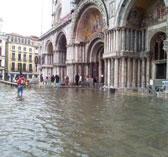UCD School of Mathematical Sciences is listening to storm surges (posted:07/01/14)
Ireland’s New Year opened dramatically with Irish coasts battered by the worst series of storms in 15 years. As compelling evidence is showing an augmented North Atlantic storminess, whose damaging effects are heightened by the sea-level rise due to global climate change, Ireland needs to respond to an increased storm-surge risk, Dr Emiliano Renzi explains…

Full Article
Ireland’s New Year opened dramatically with Irish coasts battered by the worst series of storms in 15 years. Severe coastal flooding was reported in many cities across the country, including Galway and Cork. The coastal town of Lahinch (Co Clare) alone suffered €5m worth of damage caused by a violent Atlantic storm surge. As compelling evidence is showing an augmented North Atlantic storminess, whose damaging effects are heightened by the sea-level rise due to global climate change, Ireland needs to respond to an increased storm-surge risk, Dr Emiliano Renzi explains…
“A storm surge is an unexpected sea-level rise due to the combined effect of tide, low atmospheric pressure and strong winds. At present, we are able to detect and measure a storm surge only with tidal gauges once it has made landfall. Obviously, that is too late for emergency planning and evacuation”.
Computer models often fail in predicting intensity and momentum of extreme storm surges, explains Dr Renzi, who has recently been awarded the prestigious AXA Research Fund Fellowship for research on storm surges at UCD School of Mathematical Sciences. “Numerical models are very sensitive to spatial and temporal resolution. This means that they can underestimate extreme surges generated by localised dynamic effects in space and time, like for example those violent gusts we have in Ireland”, he says.
Dr Renzi and Professor Frederic Dias, Scientific Officer of the project, are developing an innovative technology for the early detection of storm surges which combines advanced mathematical techniques with acoustic sciences. “Storm surge is a very complex phenomenon. You need an innovative multidisciplinary strategy to investigate it”, they say.
Dr Renzi ’s project presents a new way to look at the dynamics of storm surges. “While many scientists investigate storm surges with global-scale models, I believe that storm-surge extremes are instead generated by localised atmospheric perturbations in space and time which cannot be rendered by global models”. Dr Renzi and Professor Dias explain that, when such localised perturbations are strong enough to cause compression and subsequent relaxation of water particles, “you not only have the storm surge, but also high-speed underwater sound waves travelling ahead of the surge. If we are able to catch this storm-surge acoustic signature, we will be able to detect the incoming storm surge much in advance than its arrival!”. “This is like listening to the scream of the ocean, which is both scary and fascinating”, Dr Renzi explains.
From this original approach, the UCD team will develop a novel mathematical model to reconstruct amplitude and period of the incoming surge from the associated underwater acoustic signals travelling ahead of it, cheaply and safely detectable via underwater microphones (hydrophones). “Hydrophones are normally used to detect acoustic signals produced by marine mammals and, more recently, to detect tsunamis. However, no use of hydrophones for the early detection of storm surges was ever envisaged before!” Dr Renzi comments.
Dr Emiliano Renzi is beneficiary of an AXA Research Fund postdoctoral grant at UCD School of Mathematical Sciences. Professor Frederic Dias is a Senior Professor at UCD School of Mathematical Sciences on leave from ENS Cachan (France).
